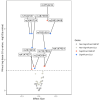Interaction Analysis Reveals Complex Genetic Associations with Alzheimer's Disease in the CLU and ABCA7 Gene Regions
- PMID: 37761806
- PMCID: PMC10531324
- DOI: 10.3390/genes14091666
Interaction Analysis Reveals Complex Genetic Associations with Alzheimer's Disease in the CLU and ABCA7 Gene Regions
Abstract
Sporadic Alzheimer's disease (AD) is a polygenic neurodegenerative disorder. Single-nucleotide polymorphisms (SNPs) in multiple genes (e.g., CLU and ABCA7) have been associated with AD. However, none of them were characterized as causal variants that indicate the complex genetic architecture of AD, which is likely affected by individual variants and their interactions. We performed a meta-analysis of four independent cohorts to examine associations of 32 CLU and 50 ABCA7 polymorphisms as well as their 496 and 1225 pair-wise interactions with AD. The single SNP analyses revealed that six CLU and five ABCA7 SNPs were associated with AD. Ten of them were previously not reported. The interaction analyses identified AD-associated compound genotypes for 25 CLU and 24 ABCA7 SNP pairs, whose comprising SNPs were not associated with AD individually. Three and one additional CLU and ABCA7 pairs composed of the AD-associated SNPs showed partial interactions as the minor allele effect of one SNP in each pair was intensified in the absence of the minor allele of the other SNP. The interactions identified here may modulate associations of the CLU and ABCA7 variants with AD. Our analyses highlight the importance of the roles of combinations of genetic variants in AD risk assessment.
Keywords: Aging; SNPs interaction; compound genotype; dementia; genetic heterogeneity.
Conflict of interest statement
The authors declare no conflict of interest.
Figures



References
-
- Saunders A.M., Strittmatter W.J., Schmechel D., George-Hyslop P.H., Pericak-Vance M.A., Joo S.H., Rosi B.L., Gusella J.F., Crapper-MacLachlan D.R., Alberts M.J. Association of Apolipoprotein E Allele Epsilon 4 with Late-Onset Familial and Sporadic Alzheimer’s Disease. Neurology. 1993;43:1467–1472. doi: 10.1212/WNL.43.8.1467. - DOI - PubMed
-
- Farrer L.A., Cupples L.A., Haines J.L., Hyman B., Kukull W.A., Mayeux R., Myers R.H., Pericak-Vance M.A., Risch N., van Duijn C.M. Effects of Age, Sex, and Ethnicity on the Association between Apolipoprotein E Genotype and Alzheimer Disease: A Meta-Analysis. JAMA. 1997;278:1349–1356. doi: 10.1001/jama.1997.03550160069041. - DOI - PubMed
-
- Ridge P.G., Hoyt K.B., Boehme K., Mukherjee S., Crane P.K., Haines J.L., Mayeux R., Farrer L.A., Pericak-Vance M.A., Schellenberg G.D., et al. Assessment of the Genetic Variance of Late-Onset Alzheimer’s Disease. Neurobiol. Aging. 2016;41:200.e13–200.e20. doi: 10.1016/j.neurobiolaging.2016.02.024. - DOI - PMC - PubMed
Grants and funding
LinkOut - more resources
Full Text Sources
Research Materials
Miscellaneous

